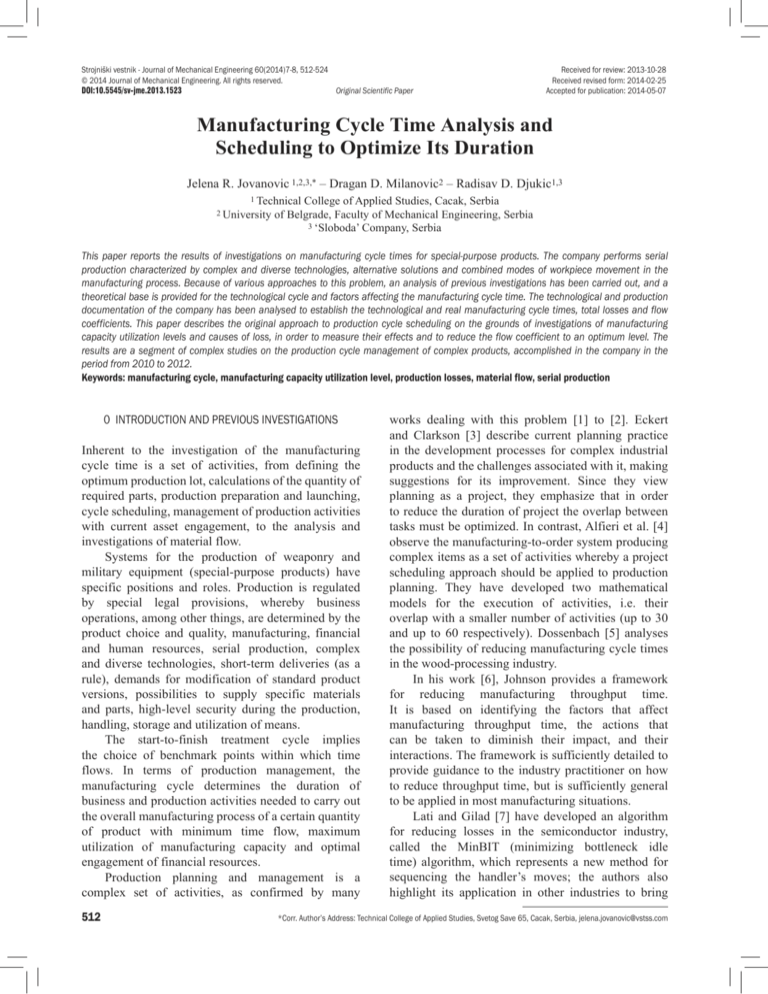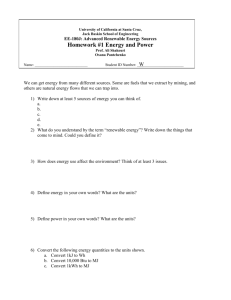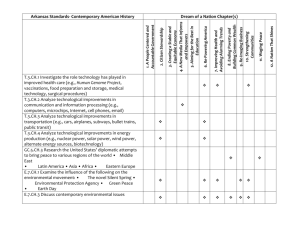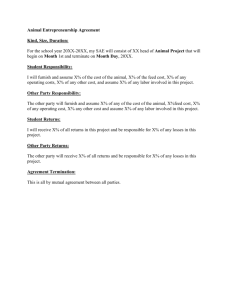
Strojniški vestnik - Journal of Mechanical Engineering 60(2014)7-8, 512-524
© 2014 Journal of Mechanical Engineering. All rights reserved. DOI:10.5545/sv-jme.2013.1523
Original Scientific Paper
Received for review: 2013-10-28
Received revised form: 2014-02-25
Accepted for publication: 2014-05-07
Manufacturing Cycle Time Analysis and
Scheduling to Optimize Its Duration
Jovanovic, J.R. – Milanovic, D.D. – Djukic, R.D.
Jelena R. Jovanovic 1,2,3,* – Dragan D. Milanovic2 – Radisav D. Djukic1,3
1 Technical
2 University
College of Applied Studies, Cacak, Serbia
of Belgrade, Faculty of Mechanical Engineering, Serbia
3 ‘Sloboda’ Company, Serbia
This paper reports the results of investigations on manufacturing cycle times for special-purpose products. The company performs serial
production characterized by complex and diverse technologies, alternative solutions and combined modes of workpiece movement in the
manufacturing process. Because of various approaches to this problem, an analysis of previous investigations has been carried out, and a
theoretical base is provided for the technological cycle and factors affecting the manufacturing cycle time. The technological and production
documentation of the company has been analysed to establish the technological and real manufacturing cycle times, total losses and flow
coefficients. This paper describes the original approach to production cycle scheduling on the grounds of investigations of manufacturing
capacity utilization levels and causes of loss, in order to measure their effects and to reduce the flow coefficient to an optimum level. The
results are a segment of complex studies on the production cycle management of complex products, accomplished in the company in the
period from 2010 to 2012.
Keywords: manufacturing cycle, manufacturing capacity utilization level, production losses, material flow, serial production
0 INTRODUCTION AND PREVIOUS INVESTIGATIONS
Inherent to the investigation of the manufacturing
cycle time is a set of activities, from defining the
optimum production lot, calculations of the quantity of
required parts, production preparation and launching,
cycle scheduling, management of production activities
with current asset engagement, to the analysis and
investigations of material flow.
Systems for the production of weaponry and
military equipment (special-purpose products) have
specific positions and roles. Production is regulated
by special legal provisions, whereby business
operations, among other things, are determined by the
product choice and quality, manufacturing, financial
and human resources, serial production, complex
and diverse technologies, short-term deliveries (as a
rule), demands for modification of standard product
versions, possibilities to supply specific materials
and parts, high-level security during the production,
handling, storage and utilization of means.
The start-to-finish treatment cycle implies
the choice of benchmark points within which time
flows. In terms of production management, the
manufacturing cycle determines the duration of
business and production activities needed to carry out
the overall manufacturing process of a certain quantity
of product with minimum time flow, maximum
utilization of manufacturing capacity and optimal
engagement of financial resources.
Production planning and management is a
complex set of activities, as confirmed by many
512
works dealing with this problem [1] to [2]. Eckert
and Clarkson [3] describe current planning practice
in the development processes for complex industrial
products and the challenges associated with it, making
suggestions for its improvement. Since they view
planning as a project, they emphasize that in order
to reduce the duration of project the overlap between
tasks must be optimized. In contrast, Alfieri et al. [4]
observe the manufacturing-to-order system producing
complex items as a set of activities whereby a project
scheduling approach should be applied to production
planning. They have developed two mathematical
models for the execution of activities, i.e. their
overlap with a smaller number of activities (up to 30
and up to 60 respectively). Dossenbach [5] analyses
the possibility of reducing manufacturing cycle times
in the wood-processing industry.
In his work [6], Johnson provides a framework
for reducing manufacturing throughput time.
It is based on identifying the factors that affect
manufacturing throughput time, the actions that
can be taken to diminish their impact, and their
interactions. The framework is sufficiently detailed to
provide guidance to the industry practitioner on how
to reduce throughput time, but is sufficiently general
to be applied in most manufacturing situations.
Lati and Gilad [7] have developed an algorithm
for reducing losses in the semiconductor industry,
called the MinBIT (minimizing bottleneck idle
time) algorithm, which represents a new method for
sequencing the handler’s moves; the authors also
highlight its application in other industries to bring
*Corr. Author’s Address: Technical College of Applied Studies, Svetog Save 65, Cacak, Serbia, jelena.jovanovic@vstss.com
Strojniški vestnik - Journal of Mechanical Engineering 60(2014)7-8, 512-524
about cycle time reductions and throughput increases.
Hermann and Chincholkar [8] describe a decision
support tool that can help a product development team
to reduce manufacturing cycle time as early as in the
product design phase. The design for production (DFP)
tool determines how manufacturing a new product
design affects the performance of the manufacturing
system, taking into account the capacities available
and estimating the manufacturing cycle time.
Bottleneck control in real time production [9],
prioritizing machine fleet preventive maintenance
[10], spare parts inventory for maintenance,
optimization of initial buffer adjustment [11],
reduction of machine setup time [12] and predicting
order lead times [13], can lead to production effects
improvement and manufacturing cycle time reduction.
Ko et al. [14] investigate the possibility of
reducing cycle times in mass production by input and
service rate smoothing.
Based on the analysis of cited works, the
following can be concluded:
• A generally accepted approach is to use the flow
coefficient as a measure of the manufacturing
process efficiency, which rests upon the
comparison between the accomplished and
technological (ideal) values of the manufacturing
cycle.
• Investigations most commonly focus on the
cycle within the framework of one-off and smallscale production, where technological values are
determined in terms of the consecutive mode of
workpiece movement and large-scale and mass
production, and where technological values are
determined in terms of parallel moves (analysis
involves takt time and technological line
productivity).
• The technological cycle duration, under
conditions of serial production characterized by
discontinuity, is calculated using the formulas for
the consecutive or parallel mode of workpiece
move, depending on the size of the production lot
and the author’s assessments.
In terms of theoretical considerations and
industrial practice, it is of crucial importance to master
the key parameters that affect the manufacturing cycle
duration under the conditions of complex-product
serial production with dominating interruptible
processes conditioned by complex and diverse
technologies. The manufacturing process includes
highly productive machines, having standard and
specialized applications, with high concentrations
of technological operations, but also the universaltype equipment with expressed differentiation of
operations. The technological procedure embraces
both productive and non-productive operations with
the involvement of technologies used to change the
workpiece shape and features.
All the aforementioned manufacturing conditions
require an integrated approach in investigating the
manufacturing cycle that should enable its permanent
reduction through dynamic and cyclic process oriented
to:
• generating an exact theoretical framework for
calculating the technological cycle duration based
on a combined mode of organizing the sequence
of technological operations,
• identifying the causes of losses, measuring their
effects on manufacturing capacity utilization
level and cycle duration,
• manufacturing cycle design with scheduled losses
that are lower than planned, taking into account
the optimal overlap of activities, and
• production launching, analysing and measuring
the manufacturing process efficiency based on a
comparison of real and designed values.
Based on all the above-mentioned factors, it can
be inferred that cycle time duration is a stochastic
quantity directly affected by:
1. factors related to product development and
production program (e.g. total number, types,
quantities and product complexity),
2. manufacturing capacity of the system and
manufacturing process automotive level (e.g.
human resources, equipment, space),
3. financial potentials (e.g. current assets, input
inventories, size and structure of unfinished
production),
4. technologies
applied
and
manufacturing
equipment layout (e.g. workplaces),
5. volume of production and modes of workpiece
move in the manufacturing process (e.g. optimum
production lot, type of production),
6. factors related to the adopted principles of
manufacturing and informatics support in all
material flow phases,
7. methods applied in production planning,
monitoring and management, and
8. causes of cycle losses.
Total manufacturing cycle time (Fig. 1) is a highly
complex quantity composed of a range of components,
measurable and non-measurable, to be identified,
whose conditionality and behaviour regularity has
to be established. Cycle time duration consists of
productive and non-productive time. Productive time
is defined by technological operations related to
changes in the workpiece’s shape and property, while
Manufacturing Cycle Time Analysis and Scheduling to Optimize Its Duration
513
Strojniški vestnik - Journal of Mechanical Engineering 60(2014)7-8, 512-524
non-productive time involves operations related to
transport and control.
q, Eq. (2). Technological manufacturing cycle Tt ,
which is also an ideal cycle Tci, Eq. (3), includes the
time needed for performing all n operations predicted
by the technological procedure, on the products of a
single lot. Production organization plays a critical
role in determining the technological cycle, in which
moves may be consecutive Tt(u) (Eq. (4)), parallel
Tt(p) (Eq. (5)) and combined Tt(k) (Eqs. (6) or (7)),
depending on the type of production, consist of a
complex set of features.
P=
{( X , x )
j
}
j , i ∈ N , (1)
i
{
}
xi : A = {n,θ n , q} , θ n = ti i = 1, n , (2)
{
}
Tt = Tci = Tt ( p ) , Tt ( k ) , Tt (u ) , Tt ( p ) ≤ Tt ( k ) < Tt ( u ) , (3)
n
Tt (u ) =
1 TECHNOLOGICAL (IDEAL) MANUFACTURING CYCLE
The production program of the plant P, Eq. (1),
consists of products Xj and parts xi. The process
of parts manufacturing is defined by a set of data A
composed of the number of technological operations
n, ordered set θn of times per operation ti and lot size
514
(∀x i = 1, m ) ∈ P ∧ A = {n,θ , q}, (4)
,
i =1
H
i
n
n
Fig. 1. Several factors on manufacturing cycle time duration
The exposition of the investigation results will be
organized into three sections treating:
• Theoretical and technological bases for
technological (ideal) manufacturing cycle time
scheduling, depending on the mode of organizing
the sequence of operations, with investigation
results.
• Investigation of real manufacturing cycle time
duration, manufacturing capacity utilization level
(machines, human resources in manufacturing)
and causes of losses.
• Manufacturing cycle scheduling of a chosen
product, production launching according to the
designed model and investigations of the flow
coefficient K based on a comparison of realized
and designed states in the production process
(Kp), i.e. in terms of comparisons between real
and technological (ideal) cycles (Kt) calculated
using formulas for combined modes of workpiece
movements.
q ⋅ ∑ ti
Tt ( p ) =
∑ t + ( q − 1) ⋅ t
i =1
i
H
(∀x
max
)
n
∑ t + ( q − 1) ⋅ ∑ t − ∑ t
i =1
Tt ( k ) =
k −1
}
i = 1, m ∈ P ∧ A = {n,θ n , q} ,
i
(t
{
, tmax = max ti i = 1, n ,
i
) (
H
k
k
j
j
(5)
,
)
< tk ≥ tk +1∀k = 1, n ∧ t j −1 ≥ t j < t j +1∀j = 2, n − 1 ,
(∀x
)
i = 1, m ∈ P ∧ A = {n,θ n , q} ,
i
n
n
Tt ( ) =
k
∑ t + ( q − 1) ⋅ ∑ ( t
i =1
i
i =1
i
− ti −1 ) ⋅ Fi
H
(6)
,
ti > ti −1 ⇒ Fi = 1 ∧ ti ≤ ti −1 ⇒ Fi = 0 ∧ t0 = 0,
(∀x
i
)
i = 1, m ∈ P ∧ A = {n,θ n , q}.
(7)
Depending on the time units in which the cycle
time duration is expressed, the values of parameter H
are determined by Eqs. (8) to (11).
H = 1 → Tt [norm hours/lot],
(8)
H = CS → Tt [shift/lot],(9)
H = CS · Sd → Tt [workdays/lot],(10)
H = Cs ⋅ S d ⋅
Jovanovic, J.R. – Milanovic, D.D. – Djukic, R.D.
D
1
, δ = k → Tt [ calendar days / lot ] ,(11)
δ
Dr
Strojniški vestnik - Journal of Mechanical Engineering 60(2014)7-8, 512-524
emerging at some workplaces (operations) of a parallel
type due to the different durations of successive
operations, Fig. 2.
where:
ti total time per technological operation in norm
hour/piece,
Cs effective working hours in a shift,
Sd number of shifts per day,
Dk total number of calendar days in a corresponding
period of time,
Dr total number of workdays in a corresponding
period of time,
tmaxrun-time length of the longest technological
operation,
tk , tjtechnological operations that satisfy the condition
from Eq. (6),
Fi a constant that takes the value of 1 or 0,
δ calendar and workdays ratio.
The combined type of work flow in a
manufacturing process is most often encountered in
serial production. Its goal is to eliminate downtimes
Fig. 2. Graphic representation of a combined mode of workpiece
move in the manufacturing process
Order of
operation
Machine
code
Table 1. Sequence of technological operations with norms and technological cycle values for a job order lot of q = 30,000 pieces, in calendar
days
1
1
2
3
4
5
6
7
8
9
10
11
12
13
14
15
16
17
18
19
20
21
22
2
M1
M2
M1
M3
M4
M5
M6
M7
M8
M9
Σ
Capacity in a
shift qS
Time per
operation
[piece/shift]
[cmh/piece]
4
6
40
8
134
8
40
8
172
8
40
8
172
172
300
8
50
92
40
92
30
92
2
1522
i
3
125000
18750
93750
5600
93750
18750
93750
4300
93750
18750
93750
4300
4300
2500
93750
15000
8200
18750
8200
25000
8200
375000
H = Cs ⋅ S d ⋅
ti
Parameters for technological cycle calculations
tmax
tk
tj
Fi
(ti – ti–1) · Fi
5
300
-
6
40
134
40
172
40
172
300
92
92
92
1174
7
8
8
8
8
8
172
8
40
30
290
8
1
1
0
1
0
1
0
1
0
1
0
1
0
1
0
1
1
0
1
0
1
0
-
9
6
34
126
32
164
32
164
128
42
42
52
62
884
1
Dk 365
= 7.5 ⋅1.3 ⋅ 0.704 = 6.866, δ =
=
= 1.42,
δ
Dr 257
Tt(u) = 66.50 ≈ 67 [cal. days/lot], Tt(p) =13.11 ≈ 14 [cal. days/lot], Tt(k) =38.62 ≈39 [cal. days/lot]
Manufacturing Cycle Time Analysis and Scheduling to Optimize Its Duration
515
Strojniški vestnik - Journal of Mechanical Engineering 60(2014)7-8, 512-524
1.1 Calculations of Technological Cycle for an Analysed
Product
The analysed product is manufactured in three
displaced organizational units: 1120, 1170 and 1630.
The manufacturing process engages nine different
machines (M1 to M9). Ten types of technology are
applied, arranged into four groups: heat treatment
(one type of technology), mechanical processing/
deformation, cutting (five types of technologies),
chemical preparation (two types of technologies)
and surface finish (two types of technologies). Of
22 technological operations, 17 are manufacturing
(six operations are related to change in shape, 11 to
change of characteristics) and five operations are nonmanufacturing (four operations refer to control, one to
transport). The total time needed to produce a single
part amounts to 0.017 norm hours. The norm structure
is composed of 20% machine time (only a machine is
operating), 59% combined time (both a handler and
a machine are operating simultaneously) and 21%
manual time (only handlers are engaged).
On the grounds of technological procedure
and Eqs. (4) to (11) for a job order lot of 30,000
parts, Table 1 shows data needed for calculations of
the technological cycle as well as the cycle values
for consecutive, parallel and combined modes of
workpiece movement, Eq. (12). Technological cycle
Tt(k) is 2.95 times longer than Tt(p) and by 1.72 times
shorter than Tt(u), respectively.
The obtained results confirm the correctness
of the approach in which the flow coefficient Kt is
defined as a real to technological Tt(k) ratio instead of
Tt(u) or Tt(p) as has been the practice to date.
Tt ( p ) ≅ 14 < Tt ( k ) ≅ 39 < Tt (u ) ≅ 67. (12)
2 ANALYSIS OF CYCLE TIME AND CAUSES OF LOSSES
IN MANUFACTURING CAPACITY
Technological cycle Tt is an ideal manufacturing cycle
Tci because the corresponding Eqs. (4) to (11) do not
include losses in the cycle that are unavoidable in the
manufacturing process. Unlike technological, cycle
time, real duration Tcs includes all generated losses
Gcs. Methods for data collecting on manufacturing
cycle time duration Tcs can be arranged into three
groups.
The first group of methods is based on the
analysis of manufacturing, planning and other
documentation for the system, when it is possible to
establish the start and end dates for the manufacturing
516
process. The most commonly used manufacturing
documentation items are job order documents (term
cards, material requisition, worksheets, delivery notes,
etc.), documents of technical control and various
reports on the current state of the manufacturing
process. For the processes that are rarely repeated,
e.g. performed once a year or once in six months,
planning documentation and other documents are
used, relating to supply, reception, storage and sales
for the approximate definition of benchmark points.
The second group of methods includes those
based on the measurement of cycle time duration
and its components. The chrono-metering method
is applied for shorter cycle time durations, while the
method of current observations is used for longer
cycle time durations that are frequently repeated.
Cycle time duration is measured on a representative
sample of parts.
The third group is based on estimating the total
duration of cycle times. These methods are applied for
cases in which the above methods are not applicable
or require much effort.
2.1 Real Cycle, Losses in the Cycle and Flow Coefficient
The analysis of manufacturing documentation
(term cards and reports on the current state of the
manufacturing process) was used to determine cycle
time duration Tcs for a chosen part based on data about
the realized start and end dates of production.
Total losses in the cycle Gcs are calculated with
the help of Eq. (13) when the technological cycle
duration Tt is subtracted from the real cycle time
duration, paying attention to the type of production.
Total losses consist of intra-operational Guo and interoperational Gmo losses.
Since the company practices a serial type
of production, the total losses in the cycle Gcs,
average losses per operation ε and flow coefficient
Kt, representing the correlation between real and
technological cycle time duration, will be calculated
using Eqs. (14) to (16). Various approaches to
determining the correlation between real and
theoretical cycle time duration can be also found in
papers [15] and [16].
Gcs = Tcs − Tt = Guo + Gmo , (13)
Gcs = Tcs − Tt ( k ) , (14)
Jovanovic, J.R. – Milanovic, D.D. – Djukic, R.D.
ε=
Gcs
, (15)
n
Strojniški vestnik - Journal of Mechanical Engineering 60(2014)7-8, 512-524
Kt =
Tcs
. (16)
Tt ( k )
After the cycle time analysis has been completed,
the results are presented in Table 2 and Figs. 3 and
4. A total of 13 job orders, seven in 2010 and six in
2011 for the quantity of 30,000 pieces each year were
analysed.
production, it can be inferred that the production
planning and management process is uncontrollable,
experience-based, lacking identified and quantified
causes of losses in the cycle.
Tt ( k ) = 38.62, 78 ≤ Tcs ≤ 200, 1.8 ≤ ε ≤ 7.3,
39.4 ≤ Gcs ≤ 161.4, 2.02 ≤ K t ≤ 5.18.
Fig. 4. Flow coefficient Kt per job order
Fig. 3. Technological and real cycle time per job order
Flow coefficient Kt (Fig. 4) takes values within
2.02 to 5.18 range. Total losses in the cycle (Gcs)
measured against the technological value Tt(k) range
from 39.4 to 161.4 calendar days, and losses are
higher, on average, by 2.24 times than technological
cycle duration. Taking into account the parameters
from Eq. (17) and the fact that this is a serial repeating
(17)
2.2 Utilization of Machine Capacity and Structure of
Losses per Cause of Downtime
Taking into account the obtained results, Eq. (17),
and the importance of the analysed product that is
on a critical path of the manufacturing cycle of four
complex products making up the framework of the
2010 and 2011 production programs, the causes and
Table 2. Real manufacturing cycle time duration Tcs, total losses in the cycle Gcs, losses in the cycle per operation ε and values of flow
coefficient Kt, in calendar days
1
1
2
3
4
5
6
7
8
9
10
11
12
13
Lot
2
04/10
05/10
06/10
07/10
08/10
09/10
10/10
01/11
03/11
04/11
05/11
06/11
07/11
Job order (JO)
Manufacturing date
Quantity
Start
End
3
4
5
30000
30.08.2010
17.11.2010
30000
30.08.2010
17.01.2011
30000
30.08.2010
16.02.2011
30000
30.08.2010
17.03.2011
30000
18.09.2010
31.03.2011
30000
16.12.2010
08.04.2011
30000
16.12.2010
21.04.2011
30000
23.02.2011
06.06.2011
30000
09.04.2011
25.06.2011
30000
09.04.2011
06.07.2011
30000
07.07.2011
07.10.2011
30000
07.07.2011
23.10.2011
30000
08.09.2011
13.01.2012
Average value:
Cycle time duration
Losses
Tt(k)
Tcs
Gcs
ε
6
7
80
141
171
200
195
114
127
104
78
89
93
109
128
125.3
8 = 7–6
41.4
102.4
132.4
161.4
156.4
75.4
88.4
65.4
39.4
50.4
54.4
70.4
89.4
86.7
9
1.9
4.7
6.0
7.3
7.1
3.4
4.0
3.0
1.8
2.3
2.5
3.2
4.1
3.9
38.62
No
Manufacturing Cycle Time Analysis and Scheduling to Optimize Its Duration
Flow
coefficient
Kt
10=7/6
2.07
3.65
4.43
5.18
5.05
2.95
3.29
2.69
2.02
2.30
2.41
2.82
3.31
3.24
517
Strojniški vestnik - Journal of Mechanical Engineering 60(2014)7-8, 512-524
measurements of losses were investigated with regard
to the manufacturing capacity. The causes of losses
(i) were identified (Eq. (18)), and machine capacity
utilization level ηm was established for the operations
with machines and combined time cycles (Eq. (19)),
with respect to cycle times in the structure of normhour per technological operation. Machine capacity
utilization level and current losses, per downtime
cause, can be measured with different techniques [17].
In this investigation, the method of current
observations (MCO) was employed. The MCO
is based on mathematical statistics and sampling
theory. To apply the MCO, it is necessary to define
the representative sample, choose the time period
for screening (e.g. day, month, shift, number of
observations required per shift), perform preparations
for screening (e.g. train screeners, identify causes
of losses, prepare screening sheets, define mode of
data recording and processing, screener’s route and
sequence of screening the machines).
Test screening identified eight causes of losses
for machine capacity (i): machine breakdown (K), tool
insufficiency and failure (A), waiting for a workpiece
from the preceding operation (I), downtime caused by
handler’s lack of discipline (C), material shortage (M),
waiting for the workpiece from another organizational
unit (V), lack of jobs (X) and other causes (e.g.
downtimes due to power failure, fluid shortage,
strikes) (O). In addition to the abovementioned eight
characteristics related to current causes of losses,
another two characteristics screened were associated
with the operation of machines: machine is operating
(T) and preparation-finish jobs (P).
8
g m = ∑ gi , i = {K , A, M , C , I ,V , O, X } , (18)
i =1
ηm =
n ( −)
n( + )
, gi = i
, (19)
n
n
where:
total losses of machine capacity,
gm
gi machine capacity losses per downtime cause
(i),
n
total number of observations,
n(+) number of observations when the machine is
running,
ni(−) number of observations for machine
downtime per downtime cause (i).
Table 3. Experiment plan for measuring machine capacity utilization level and current losses, using the MCO method, accomplished in 2010
No
OU
No of
machines
1
1
2
3
2
1120/I
1170
1120/II
3
2
4
3
Data for the experiment
n11
4
20
20
20
n12
5
20
20
20
n1
n2
6=4+5
40
40
40
n3
7
10
10
10
8
12
12
12
n*
m
No of
features
9=6×7×8
4800
4800
4800
10=3×9
9600
19200
14400
11
10
10
10
Note: n11 no of observations per machine in shift 1, n12 no of observations per machine in shift 2, n1 no of observations per machine/day,
n2 no of screening days per month, n3 no of screening months per year, n* total number of observations per machine/year, m total number of
observations for all machines per organizational unit
Table 4. Utilization level ηm, total gm and partial losses gi of machine capacity, per cause of downtime and machines, and scheduled
parameters values μm
No
Mi
ηm
1
1
2
3
4
5
6
7
8
9
Average
2
M1
M2
M3
M4
M5
M6
M7
M8
M9
3
0.4600
0.5600
0.5350
0.4500
0.4900
0.5150
0.5600
0.6950
0.3700
0.5150
518
gM
4
0.1250
0.0000
0.0500
0.0000
0.0850
0.1200
0.0000
0.0000
0.0000
0.0422
gA
Values of partial losses gi, per cause of downtime (i)
5
0.0200
0.0250
0.0650
0.0500
0.0500
0.0250
0.0450
0.0600
0.0050
0.0383
gK
6
0.1150
0.0000
0.1450
0.1050
0.0400
0.0150
0.0750
0.0200
0.1650
0.0756
gC
7
0.0450
0.0250
0.0300
0.0250
0.0550
0.0150
0.0500
0.0900
0.0200
0.0394
gX
8
0.1800
0.2150
0.1650
0.2150
0.2500
0.3000
0.0900
0.0000
0.3850
0.2000
gI
9
0.0000
0.1450
0.0000
0.1400
0.0000
0.0000
0.1350
0.0900
0.0550
0.0628
Jovanovic, J.R. – Milanovic, D.D. – Djukic, R.D.
gV
10
0.0000
0.0000
0.0000
0.0000
0.0000
0.0000
0.0000
0.0000
0.0000
0.0000
gO
11
0.0550
0.0300
0.0100
0.0150
0.0300
0.0100
0.0450
0.0450
0.0000
0.0267
gm
μm
12
0.5400
0.4400
0.4650
0.5500
0.5100
0.4850
0.4400
0.3050
0.6300
0.4850
13=3+4+8
0.7650
0.7750
0.7500
0.6650
0.8250
0.9350
0.6500
0.6950
0.7550
0.7572
Strojniški vestnik - Journal of Mechanical Engineering 60(2014)7-8, 512-524
Table 3 shows the experiment plan, and Table 4
displays the results obtained by the program developed
in paper [18]. Table 4 (column 13) shows scheduled
values for machine capacity utilization levels μm, Eq.
(20) to be used for scheduling manufacturing cycle
time optimum values Tcp. The scheduled capacity
utilization level (μm) is essentially the potential of each
of nine engaged machines (Mi). Its value, Relation
(20), includes losses caused by material shortages
(gM) and lack of jobs (gX).
The average machine’s utilization engaged in
the manufacturing process of an analysed product in
2010 amounts to 51.5%. Individually, per machine, it
ranges from 37 to 69.5% (Table 4, column 3).
paid and unpaid leave (o), national holidays (dp),
and engagement in other jobs (d). The total number
of employed workers (zu) is the sum of productive
(z) and clerical (za) workers. The average number of
productive workers present at work every day (zr) is
the difference between the total number of productive
workers and the average number of productive
workers absent from work for all the abovementioned
reasons (zg), Eq. (23). The scheduled norm hours (nh)
load per worker (Fnc), coefficient of productive worker
overtime engagement (ξr) and scheduled productive
worker utilization level (μr) can be calculated by
employing Eqs. (24) to (26).
µm = η m + ( g M + g X ) . (20)
ηr =
8
2.3 Productive Human Resources Utilization Level and
Current Losses per Cause of Working Hour Loss
zr
, (21)
z
}
j = b1 , b2 , i, g o , pr , o, d p , d , (22)
j =1
zu = z + za , zr = z − z g , (23)
The goal of each business-manufacturing system is to
have the optimum number of employees (zu) in both
administration (za) and production (z). Investigations
of the causes for losses in working hours and
productive human resources utilization level ηr are
of significance for workplaces and technological
operations with prevailing manual work [19].
In order to identify and reveal regularities in
causes for working hour losses, corresponding data
were collected and analysed in human resources
department in the year 2010. The human resources
utilization level ηr, Eq. (21), and current losses (zj),
per cause (j), were established based on handlers’
work records. The analysis indicated eight causes of
working hour losses (j), Eq. (22): sick leave up to 30
days (b1), sick leave over 30 days (b2), unexcused
absence from work and tickets out (i), holiday (go),
downtime (e.g. lack of jobs, strikes, vis major) (pr),
z
=
{
zg = ∑ z j ,
z − zg
Fnc = Dr ⋅ Cs ⋅ p n ,
ξr =
pn =
∑ NC , (24)
∑ EC
zr ⋅ Fnc + Pe
, (25)
zr ⋅ Fnc
µr = η r ⋅ ξ r . (26)
The scheduled norm hours load per worker (Fnc)
is obtained as the product of the total number of
working days (Dr), effective working hours in a shift
(Cs) and the average norm hour [nh] execution (pn) for
the observed organizational unit and a corresponding
time period. The average norm-hour is obtained when
the executed norm-hours (NC) are divided by the
engaged effective working hours (EC) of productive
1
800
[workers/year]
zg
[%]
zb1
zb2
zi
zgo
zdp
zpr
zo
zd
[%]
[workers/
year]
2
6.15
3
1.8
4
1.35
5
11.4
6
2.85
7
1.8
8
1.35
9
0.3
10
27
11
216
zr
zj, j = {b1, b2, i, go, dp, pr, o, d}
z
[workers/year]
Table 5. Productive human resources utilization level ηr, total zg and partial zj losses of working hours, and scheduled parameter values μr
12=1-11
584
ηr
Pe
[%]
[nh/
year]
Fnc
ξr
13
73
14
163917
15
2217
16
1.13
Fnc = Dr ⋅ Cs ⋅ pn = 257 ⋅ 7.5 ⋅1.15 = 2217 [nh/worker annually],
ξr =
zr ⋅ Fnc + Pe 584 ⋅ 2217 + 163917
=
= 1.13, µ r = η r ⋅ ξ r = 0.73 ⋅1.13 = 0.82.
zr ⋅ Fnc
584 ⋅ 2217
Manufacturing Cycle Time Analysis and Scheduling to Optimize Its Duration
519
Strojniški vestnik - Journal of Mechanical Engineering 60(2014)7-8, 512-524
workers per worksheet. The coefficient of overtime
engagement depends on the specificity of workplaces
and planned level of overtime hours (Pe).
Table 5 show parameters relevant to the
utilization of productive human resources (PHR).
Due to an adverse age structure, working hours losses
are high on account of sick leave (b1, b2) and holiday
(go). Of the total of 800 workers, 27% or 216 workers
are, on average, absent from work. Productive human
resource (PHR) utilization level amounts to 73%.
Taking into account the coefficient of overtime
engagement (ξr), the scheduled utilization level of
PHR (μr) equals 82%.
3 MANUFACTURING CYCLES SCHEDULING
τi =
q
⋅ δ , (28)
qsi ⋅ pi ⋅ S di ⋅ µi ⋅ ri
k
(
)
Tcp = τ 1 + ( n − 1) ⋅ ∆τ + ∑ τ p − τ p −1 ,
p
(
)
p = i i = 2, n ∧ τ i > τ i −1 → ∑ p = k , (29)
k
τ 1 + ( n − 1) ⋅ ∆τ + ∑ (τ p − τ p −1 ) = Tt + Gcp →
p
k
∆τ =
(
Tt + Gcp − τ 1 − ∑ τ p − τ p −1
p
)
n −1
,
(30)
The optimization of manufacturing cycle times Tcp
requires, first of all, investigations of losses causes,
measurement of their values, minimization of their
effects and scheduling of total losses Gcp to be lower
than made Gcs, Fig. 5.
where:
τi scheduled duration of technological operations,
Δτ average partial loss between technological
operations,
p technological operation satisfying the condition
from Eq. (29).
Fig. 5. Technological, scheduled and real manufacturing cycle
time duration with corresponding losses
Fig. 6. Scheduled loss Δτi, τi > τi–1
When scheduling the manufacturing cycles,
the scheduled cycle duration Tcp should tend to
the optimum, Fig. 5. In other words, the goal of
scheduling as a cyclic process is to permanently tend
to the minimization of total losses, which means that
scheduled losses (Gcp) should always be less than
generated (Gcs) in all optimization steps, Eq. (27).
Tcp = Tt + Gcp , Tcs = Tt + Gcs = Tcp + G,
Tt < Tcp < Tcs → Gcp < Gcs .
(27)
The scheduled manufacturing cycle duration
Tcp, Eq. (29), Figs. 6 and 7, aside from productive
and non-productive cycle times, predicted by
technological procedures, take into account scheduled
manufacturing capacity utilization levels μi(μm, μr),
Eqs. (20) and (26), real manufacturing conditions per
operation, Eq. (28) and scheduled losses in a cycle
(Gcp, ∆τ), Eq. (30).
520
Fig. 7. Scheduled loss Δτi, τi ≤ τi–1
3.1 Algorithm for Cycle Scheduling
The first step in the scheduling process is calculating
the manufacturing cycle time duration per
operation (τi) using Eq. (28), with respect to real
manufacturing conditions: the number of workplaces
Jovanovic, J.R. – Milanovic, D.D. – Djukic, R.D.
Strojniški vestnik - Journal of Mechanical Engineering 60(2014)7-8, 512-524
per technological operation (ri), the number of shifts
per day (Sdi), the average norm-hour execution (pi),
manufacturing capacity utilization μi (μm, μr) and the
norm-set capacity per shift (qSi), Table 6. Inventories
in unfinished production and losses due to quality
inadequacy are included in calculations via the
formulas for planning the quantity (q) of the product
to be produced.
3
1
2
1
2
1
2
1
2
1
2
1
2
2
2
1
2
1
2
2
1
1
1
6
0.820
0.765
0.820
0.775
0.820
0.765
0.820
0.750
0.820
0.665
0.820
0.825
0.935
0.650
0.820
0.820
0.820
0.695
0.820
0.755
0.820
0.820
7
0.38
0.73
0.51
1.57
0.49
0.73
0.50
1.50
0.51
0.81
0.51
1.43
1.29
2.08
0.49
0.75
1.89
0.74
1.34
2.11
1.87
0.12
τp – τp–1
5
1.10
1.02
1.08
1.04
1.13
1.02
1.10
1.10
1.09
1.06
1.09
1.05
1.03
1.05
1.13
1.15
1.12
1.10
1.18
1.07
1.13
1.18
[calendar days]
4
1
2
1
3
1
2
1
4
1
2
1
4
4
6
1
2
3
2
2
1
3
1
τi
operations
μi
p
Average execution of
norm-hours pi
Sdi
No of shifts
qSi
2
125000
18750
93750
5600
93750
18750
93750
4300
93750
18750
93750
4300
4300
2500
93750
15000
8200
18750
8200
25000
8200
375000
No of workplaces ri
1
1
2
3
4
5
6
7
8
9
10
11
12
13
14
15
16
17
18
19
20
21
22
Capacity in a shift
Order of operation
Table 6. Parameters for scheduling the manufacturing cycle
8
9
√
0.35
√
1.06
√
0.24
√
1.00
√
0.30
The scheduled value of total losses Gcp can be
also found using Eq. (32).
The expected cycle time duration Tc will be
calculated by applying Eqs. (6) or (7) if the values
of the technological times per operation ti (Table
1, column 4) are corrected by the corresponding
coefficients μi (Table 6, column 6). Data required for
calculating the expected values of cycle duration Tc
are given in Table 7.
According to the investigations [20], total
losses in the cycle in the company follow the beta
distribution, where the value Gc˝= Mo = 15.97 has the
highest probability (modal value).
Based on the above analysis, total loss Gcp of 16
calendar days was adopted, and partial loss Δτ was
calculated in calendar days, Eq. (33):
k
0.92
√
0.79
√
√
0.26
1.13
√
√
Σ
0.60
0.77
7.42
In the second step, it is necessary to adopt the
total losses in the cycle Gcp, and, then using Eq.
(30), to determine average partial losses between
technological operations Δτ. Total scheduled losses
in the cycle should be lower than those average (86.7
calendar days). They can be determined in a number of
ways: by the help of Eq. (31) adopting the minimum
value of losses in the cycle Gcs (Table 2, column 8).
Gcp ≤ min Gcs , Gcp ≤ 39.4,
min Gcs = min {41.4 102.4 132.4 ... 89.4}. (31)
∆τ =
(
Tt + Gcp − τ 1 − ∑ τ p − τ p −1
p
n −1
)
= 2.2. (33)
The third step implies calculating scheduled
values for the cycle Tcp, in calendar days, using data
from Table 6 and Eq. (29):
√
Gcp = Tc − Tt ( k ) . (32)
k
(
)
Tcp = τ 1 + ( n − 1) ⋅ ∆τ + ∑ τ p − τ p −1 = 54. (34)
p
Correlation between real Tcs and scheduled Tcp
manufacturing cycle time duration is determined by
the flow coefficient Kp, Eq. (35).
Kp =
Tcs
. (35)
Tcp
3.2 Production Launching According to the Scheduled
Model and Analysis of Results
The scheduled mode of manufacturing (Tcp) was
realized in two production lots (job order lot 11/11 and
13/11) in 2011 and 2012. In both job order lots, the
quantity of 30,000 pieces each was launched. Prior to
production initiation, in the ‘Term card’ document, the
scheduled start and end dates for the manufacturing
process per operation were recorded (with respect to
the results obtained in Section 3.1).
When determining and recording the dates in
the ‘Term card’, it is necessary to calculate temporal
reserves between the end and start dates of production
Manufacturing Cycle Time Analysis and Scheduling to Optimize Its Duration
521
Strojniški vestnik - Journal of Mechanical Engineering 60(2014)7-8, 512-524
Table 7. Parameters for calculating expected cycle time duration Tc
Order of
operation
Machine
code
1
1
2
3
4
5
6
7
8
9
10
11
12
13
14
15
16
17
18
19
20
21
22
2
M1
M2
M1
M3
M4
M5
M6
M7
M8
M9
-
Time per
operation ti
[cmh/piece]
3
6
40
8
134
8
40
8
172
8
40
8
172
172
300
8
50
92
40
92
30
92
2
Parameters for calculating technological cycle time
μi
Corrected time
per operation
[cmh/ piece]
tk
tj
Fi
4
0.820
0.765
0.820
0.775
0.820
0.765
0.820
0.750
0.820
0.665
0.820
0.825
0.935
0.650
0.820
0.820
0.820
0.695
0.820
0.755
0.820
0.820
5=3/4
7
52
10
173
10
52
10
229
10
60
10
208
184
462
10
61
112
58
112
40
112
2
6
52
173
52
229
60
208
462
112
112
112
-
7
10
10
10
10
10
184
10
58
40
-
8
1
1
0
1
0
1
0
1
0
1
0
1
0
1
0
1
1
0
1
0
1
0
9
7
45
0
163
0
42
0
219
0
50
0
198
0
278
0
51
51
0
54
0
72
0
342
-
1230
G
Kp
8=7-6
17
7
12
9=7/6
1.31
1.13
1.22
1984
1572
Σ
1522
= (1984 + 29999·(1572–342)) / 100000 / 6.866 = 53.74 [calendar days/lot]
Eq. (32) → Gcp = 53.74 – 38.62 = 15.12 ≈16 [calendar days/lot]
(ti
– ti–1)· Fi
Eq. (6) → Tc
Table 8. Parameters of the cycle established after production is finished according to the scheduled model
Job order
No
1
1
2
Lot
Quantity
2
11/11
13/11
3
30000
Manufacturing cycle
Date
Start
4
24.10.2011
05.12.2011
End
5
02.01.2012
03.02.2012
Tcp
Tcs
6
7
71
61
66
54
Average value:
on a current operation. Their value depends on the
scheduled partial loss Δτ and organizational mode
of production (Figs. 6 and 7). During production
activities per technological operation, the start and
end dates of production were added to the column
denoting scheduled dates.
After production is finished according to the
designed model, Table 8 shows realized manufacturing
cycle time duration (Tcs), losses in the cycle (G) and
values of the flow coefficient Kp, Relation (35).
Table 9 displays parameters (Tcs, G, Kp, Kt) for
15 job orders of the analysed part, whose production
522
was realized in the period from 2010 to 2012. In the
first 13 job orders (Nos 1 to 13), the manufacturing
cycle was not scheduled; therefore production process
management was performed based on experience and
priorities defined by operational managers.
The achieved values of the cycle Tcs (Table 9,
column 5, Nos 14 and 15) are considerably lower
than the analysed values of the cycles per job order
(Table 9, column 5, Nos 1 to 13). The flow coefficient
Kp (1.13 to 1.31) takes considerably lower values than
the coefficient Kt (2.02 to 5.18), which implies that
Jovanovic, J.R. – Milanovic, D.D. – Djukic, R.D.
Strojniški vestnik - Journal of Mechanical Engineering 60(2014)7-8, 512-524
Table 9. Values of the flow coefficients (Kp, Kt) before and after production launching according to the designed model
No
1
1
2
3
4
5
Lot
2
04/10
05/10
06/10
07/10
08/10
6
09/10
7
8
9
10
11
10/10
01/11
03/11
04/11
05/11
12
13
Job order
Quantity
3
Manufacturing cycle and losses
Tcp
Tcs
G
4
5
6= 5-4
80
26
141
87
171
117
200
146
195
141
Kt
Production
7=5/4
1.48
2.61
3.17
3.70
3.61
8
2.07
3.65
4.43
5.18
5.05
9
Experiencebased
production
114
60
2.11
2.95
127
104
78
89
93
73
50
24
35
39
2.35
1.93
1.44
1.65
1.72
3.29
2.69
2.02
2.30
2.41
06/11
109
55
2.02
2.82
07/11
128
125.3
71
61
66
74
71.3
17
7
12
2.37
2.32
1.31
1.13
1.22
3.31
3.24
1.84
1.58
1.71
30000
54
Average value:
14
15
Kp
11/11
13/11
30000
54
Average value:
the coefficient Kp is more suitable for measuring the
production process efficiency than the coefficient Kt.
4 CONCLUSION AND FURTHER RESEARCH
The goal of the original approach demonstrated in
this work is to reduce manufacturing cycle time to
the maximum, taking into account serial production
characterized by discontinuity and the considerable
amount of current assets needed for financing the
production process. This methodology is based
on designed models that, on one hand, respect
current technical-technological and manufacturing
documentation and, on the other, real production
constraints. The parameters for reducing manufacturing
cycle are flow coefficients Kp and Kt (Fig. 8).
When measured by flow coefficients Kp and
Kt, the average realized manufacturing cycle time
duration, according to the designed model, is lower
by 1.9 times (Table 9, columns 7 and 8), while the
average losses in the cycle are smaller by 5.9 times
(Table 9, column 6). Viewed from the angle of the
manufacturing system, the flow coefficient Kp has a
higher use value (Eq. (35)), because the accomplished
values of the cycle are correlated with scheduled
(planned) values. In this context, the model design
becomes a cyclical process with the aim of minimizing
total losses and reducing them to an optimal (i.e.
acceptable) level. However, to compare the results
with other business-manufacturing systems, from
Designed
model-based
production
the region and more distant areas, priority should be
given to flow coefficient Kt, Eq. (16), because the
values achieved for the cycle are compared to the
technological (ideal) cycle, which is calculated for
the case of serial production and combined workpiece
move using Eqs. (6) or (7).
Fig. 8. Values of flow coefficients Kp and Kt per job order before
and after scheduling
The results related to the identification of
downtime causes and losses measurement are of
importance not only for the cycle scheduling, but also
for optimal production planning.
Further research should be directed to the
analysis and scheduling of manufacturing cycle for
complex products. It is necessary to define models
for describing the structures of complex products
Manufacturing Cycle Time Analysis and Scheduling to Optimize Its Duration
523
Strojniški vestnik - Journal of Mechanical Engineering 60(2014)7-8, 512-524
with respect to technological documentation and
techniques that allow for the scheduling approach
to realization of orders. The designed solutions, that
are based on the principles of lean production, should
make provisions for software application solutions
from the domain of project management.
5 REFERENCES
[1] Slak, A., Tavcar, J., Duhovnik, J. (2011). Application
of genetic algorithm into multicriteria batch
manufacturing scheduling. Strojniški vestnik - Journal
of Mechanical Engineering, vol. 57, no. 2, p. 110-124,
DOI:10.5545/sv-jme.2010.122.
[2] Suzic, N., Stevanov, B., Cosic, I., Anisic, Z.,
Sremcev, N. (2012). Customizing products through
application of group technology: A case study of
furniture manufacturing. Strojniški vestnik - Journal of
Mechanical Engineering, vol. 58, no. 12, p. 724-731.
DOI:10.5545/sv-jme.2012.708.
[3] Eckert, C., Clarkson, P. (2010). Planning development
processes for complex products. Research in
Engineering Design, vol. 21, no. 3, p. 153-171,
DOI:10.1007/s00163-009-0079-0.
[4] Alfieri, A., Tolio, T., Urgo, M. (2011). A project
scheduling approach to production planning with
feeding precedence relations. International Journal
of Production Research, vol. 49, no. 4, p. 995-1020,
DOI:10.1080/00207541003604844.
[5] Dossenbach, T. (2000). Manufacturing cycle time
reduction - a must in capital project analysis. Wood &
Wood Products, vol. 105, no. 11, p. 31-35.
[6] Johnson, J.D. (2003). A framework for reducing
manufacturing through put time. Journal of
Manufacturing Systems, vol. 22, no. 4, p. 283-298,
DOI:10.1016/S0278-6125(03)80009-2.
[7] Lati, N., Gilad, I. (2010). Minimising idle times in
cluster tools in the semiconductor industry. International
Journal of Production Research, vol. 48, no. 21, p.
6443-6459, DOI:10.1080/00207540903280556.
[8] Herrmann, J.W., Chincholkar, M.M. (2000). Design
for production: A tool for reducing manufacturing
cycle time. Proceedings of the 2000 ASME Design
Engineering Technical Conference, Baltimore, from:
http://www.isr.umd.edu/Labs/CIM/projects/dfp/
dfm2000.pdf.
[9] Li, L., Chang, Q., Ni, J., Biller, S. (2009). Real
time production improvement through bottleneck
524
control. International Journal of Production
Research, vol. 47, no. 21, p. 6145-6158,
DOI:10.1080/00207540802244240.
[10]Patti, A.L., Watson, K.J. (2010). Downtime variability:
the impact of duration-frequency on the performance
of serial production systems. International Journal of
Production Research, vol. 48, no. 19, p. 5831-5841,
DOI:10.1080/00207540903280572.
[11]Schultz, C.R. (2004). Spare parts inventory and cycle
time reduction. International Journal of Production
Research, vol. 42, no. 4, p. 759-776, DOI:10.1080/0020
7540310001626210.
[12]Kusar, J., Berlec, T., Zefran, F., Starbek, M. (2010).
Reduction of machine setup time. Strojniški vestnik Journal of Mechanical Engineering, vol. 56, no. 12, p.
833-845.
[13]Berlec, T., Govekar, E., Grum, J., Potocnik, P., Starbek,
M. (2008). Predicting order lead times. Strojniški
vestnik - Journal of Mechanical Engineering, vol. 54,
no. 5, p. 308-321.
[14]Ko, S.S., Serfozo, R., Sivakumar, A.I. (2004). Reducing
cycle times in manufacturing and supply chains by input
and service rate smoothing. IIE Transactions, vol. 36,
no. 2, p. 145-153, DOI:10.1080/07408170490245441.
[15]Puich, M. (2001). Are you up to the cycle-time
challenge?. IIE Solutions, vol. 33, no. 4, p. 24-28.
[16]Hadas, L., Cyplik, P., Fertsch, M. (2009).
Method of buffering critical resources in maketo-order shop floor control in manufacturing
complex products. International Journal of
Production Research, vol. 47, no. 8, p. 2125-2139,
DOI:10.1080/00207540802572582.
[17]Djukic, R., Jovanovic, R.J., Mutavdzic, M. (2009).
Investigations of machine capacity utilization level,
downtime causes and structure of losses. Proceedings
of Jupiter Conference, Belgrade, p. 4.11-4.16. (in
Serbian)
[18]Djukic, R., Milanovic, D., Jovanovic, R.J. (2010).
Program for establishing machine capacity utilization
level. Proceedings of Quality Conference, Kragujevac,
from:
http://www.cqm.rs/2010/pdf/37/37.pdf.
(in
Serbian)
[19]Djukic, R., Jovanovic, R.J. (2009). Effects of human
resources on dynamic management of manufacturing
systems. Proceedings of Jupiter Conference, Belgrade,
p. 4.1-4.6. (in Serbian)
[20]Djukic, R. (2010). Dynamic balance and managing of
complex business-manufacturing systems. PhD Thesis.
University of Belgrade, Belgrade. (in Serbian)
Jovanovic, J.R. – Milanovic, D.D. – Djukic, R.D.







